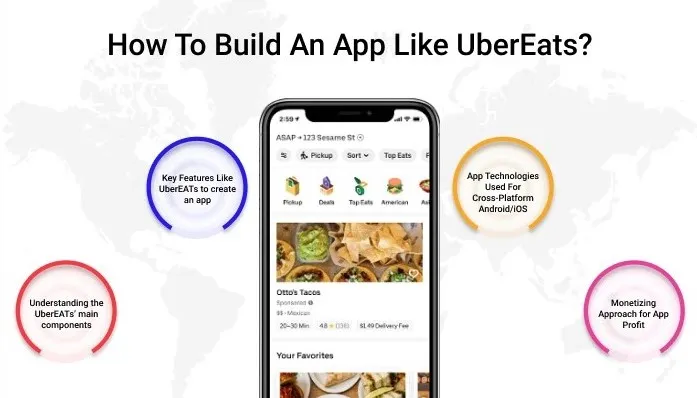5 Simple Techniques For Food delivery marketplace

The food service sector has seen rapid expansion in the past few years, driven by growing demand for convenient on-demand services. With platforms such as Uber Eats and DoorDash revolutionizing the way consumers request meals, the focus has moved to developing cutting-edge food delivery apps. These apps provide customers the ability to place orders from their favorite restaurants and have it brought right to their location. For businesses, the task is to leverage technology to enhance delivery logistics and ensure a smooth user journey.
Building the Perfect Food Delivery App
Developing a profitable food delivery app demands a thorough understanding of the industry shifts and business models that lead the industry. Whether creating a full-stack delivery solution or concentrating on niche markets like ghost kitchens or cloud kitchens, the app’s features must to cater to both users and restaurants. Key features such as real-time order monitoring, efficiency improvement, and user satisfaction indicators play a critical role in guaranteeing customer loyalty.
Restaurant Delivery Partnerships: A Winning Strategy
Restaurants are increasingly forming partnerships with delivery platforms to increase their market penetration. These partnerships help restaurants cater to a larger audience while minimizing the challenges of running their in-house delivery operations. The success of such alliances hinges upon technological synchronization, which enhances the app usability and improves the customer experience. Through these collaborations, restaurants can increase customer loyalty and make sure that they remain relevant in a crowded market.
How KPIs Drive Food Delivery Profitability
For any business, knowing its performance metrics is essential to maintaining financial health. In the food delivery sector, KPIs such as delivery time, precision in orders, and customer satisfaction are critical. Tracking and optimizing these KPIs enables delivery services to offer a superior customer experience. Moreover, keeping an eye on profitability aids companies optimize operations, reduce charges, and increase overall effectiveness.
Customer Satisfaction and User Retention Strategies
A significant factor in the growth of delivery apps is their capacity to retain users through excellent customer service. Providing quick service and addressing user feedback swiftly can assist companies enhance their service delivery. Moreover, implementing rewards systems and offering incentives like no-cost delivery can increase customer loyalty. User happiness can be additionally bolstered by maintaining quality assurance and providing DoorDash a smooth order management system.
The Role of Technology in Food Delivery
Innovative solutions is at the heart of modern food delivery solutions, enabling companies refine their operations and deliver a smooth customer experience. From app creation to real-time delivery tracking systems, technology has a critical role in the growth of delivery platforms. The use of data analytics to understand user profiles and preferences allows delivery services to offer personalized experiences, furthermore enhancing user engagement.
Competitive Analysis in the Food Delivery Market
The delivery sector is highly competitive, with numerous players competing for market share. Conducting a market evaluation allows companies to gauge their position in the market and spot chances for growth. Delivery platforms must stand out by providing unique features such as virtual restaurant options, fast delivery times, or specialized cuisine options. Analyzing market share and consumer behavior empowers companies to tailor their services and remain ahead of the rivals.
The Impact of the Pandemic on Food Delivery Services
The global health crisis has had a profound impact on the delivery services, boosting its growth as more Click for Details people turned to on-demand apps due to social distancing guidelines. The change has emphasized the importance of digital transformation in the culinary sector, with restaurants rapidly adopting online food ordering and delivery apps. As the world adjusts to new routines, food delivery businesses must persist in innovating to satisfy changing consumer demands and ensure business growth.
Investing in Food Delivery Startups
The food delivery industry presents numerous entrepreneurial chances, with investors eager to support companies that provide unique solutions. From developing similar platforms to developing niche delivery apps, entrepreneurs have a variety of paths to explore. Investors look for strong operation plans and the capacity to grow, particularly in areas like system efficiency, customer interface, and tech integration. By concentrating on these sectors, startups can attract significant investments and establish themselves in the market.
Enhancing Food Delivery Service Profitability and Expansion
Growing a food delivery service requires a strong foundation built on customer acquisition, cost models, and unique offerings. As local delivery services grow, businesses should focus on establishing a dependable logistical system and ensuring food safety. In addition, widening the menu options, forming new restaurant partnerships, and adopting advanced technology in food delivery will drive further expansion. By constantly enhancing delivery times and ensuring high customer satisfaction, companies can sustain a market lead and boost revenue generation.
These topics provide a comprehensive understanding of the food delivery ecosystem, with a emphasis on key aspects that drive the industry forward. Whether whether you are a new company or an experienced business, focusing on these factors will assist you thrive in the competitive world of food delivery.